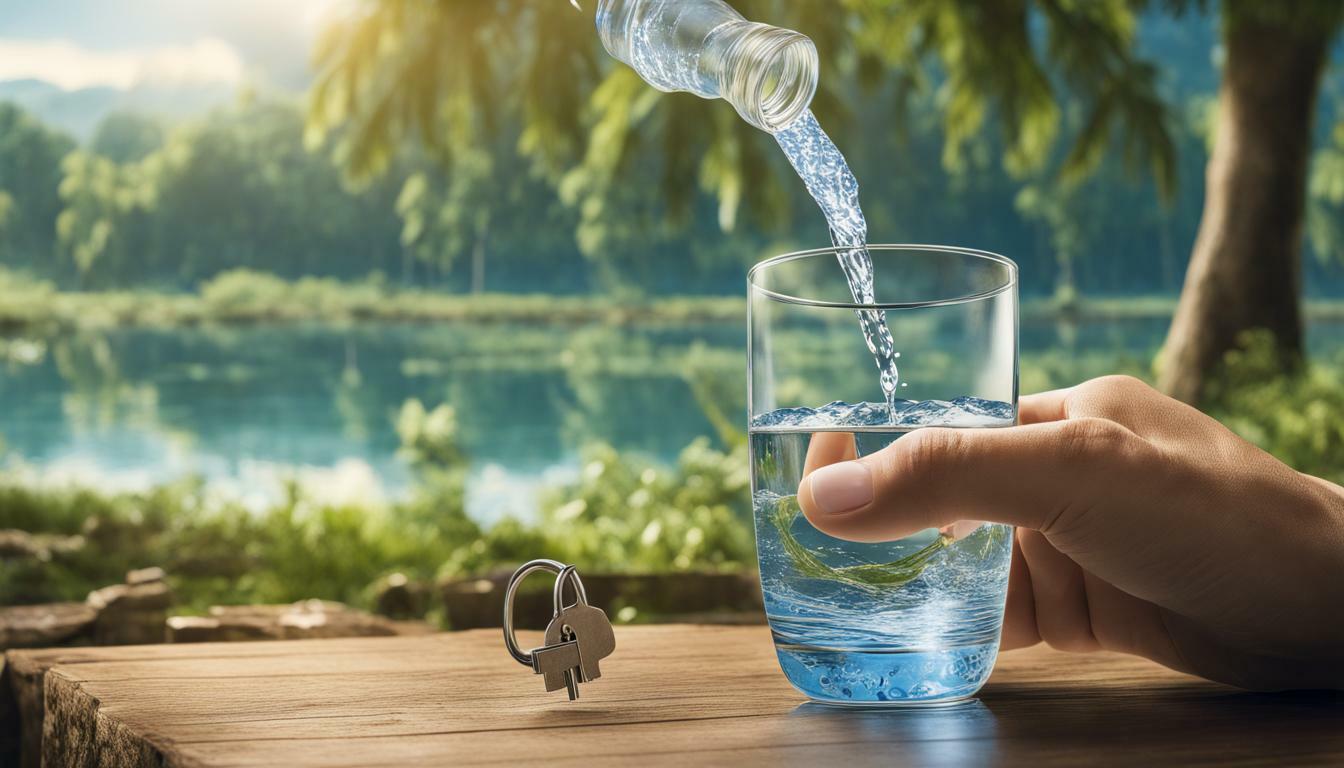Water is an essential resource for life, and the importance of ensuring safe water sources cannot be overstated. Access to clean drinking water is vital for your health and well-being, as well as the health of your community. The good news is that there are strategies and methods that can be employed to achieve cleaner and safer water sources.
By investing in water quality testing, implementing effective water treatment solutions, and practicing responsible water management techniques, we can all play a part in ensuring safe water sources for ourselves and future generations. In this article, we will explore these crucial aspects of maintaining clean and healthy water sources.
Key Takeaways
- Ensuring safe water sources is vital for your health and the health of your community.
- Investing in water quality testing is essential in identifying contaminants and maintaining water safety standards.
- Various water purification methods such as filtration, disinfection, and reverse osmosis can be employed to remove contaminants and prevent drinking water contamination.
- Implementing effective water treatment solutions such as chlorination, UV treatment, and chemical disinfection can prevent waterborne diseases.
- Effective water management through water filtration techniques, conservation strategies, and regular maintenance can promote clean and sustainable water supplies.
Understanding Water Quality Testing
Ensuring safe water sources is crucial for your health and the well-being of your community. One of the key aspects of achieving clean drinking water is water quality testing. Regular testing is essential to identify any potential contaminants and ensure compliance with water safety standards and regulations.
Water Safety Standards: The government has set water safety standards to ensure safe drinking water. These standards are designed to limit the level of certain contaminants that may be present in public water systems. The Environmental Protection Agency (EPA) regulates public water systems to make sure they comply with these standards.
There are various testing methods available for identifying contaminants in water. Some of the commonly used methods include:
| Method | Description |
|---|---|
| Microbial testing | Checks for bacteria or other microorganisms that can cause waterborne illnesses. |
| Chemical testing | Checks for chemicals such as lead, pesticides, and nitrates that can be harmful if present in high concentrations. |
| Physical testing | Checks for physical characteristics such as color, odor, and turbidity (cloudiness), which can indicate the presence of contaminants. |
It’s important to note that different contaminants require different testing methods for accurate detection. Therefore, depending on the sources of your drinking water, you may need to test for different types of contaminants.
Water Quality Testing Frequency
The frequency of water quality testing can vary depending on the source and the regulations in place. Public water systems are required to test their water regularly and provide annual reports to their consumers. However, if you rely on private well water, you are responsible for testing the water yourself. It’s recommended to test private well water at least once a year, or more frequently if there are concerns about water quality or if there have been changes in the source water.
In conclusion, understanding water quality testing is essential in ensuring safe water sources. Regular testing can help identify potential contaminants and ensure compliance with water safety standards and regulations. Stay informed and take action to protect the health of yourself and your community.
Exploring Water Purification Methods
Ensuring clean and safe drinking water is essential for maintaining good health. When it comes to achieving this goal, water purification methods can play a vital role in removing harmful contaminants and bacteria from water sources. Let’s explore some popular water purification methods.
Filtration
Filtration is a common water purification method that involves using a physical barrier to remove impurities from water. This method can effectively remove sediment, debris, and large particles from water sources. Activated carbon filters are another type of filtration method that can remove chlorine, pesticides, and other chemicals from drinking water.
| Filtration Pros | Filtration Cons |
|---|---|
| – Removes large particles from water – Reduces bad taste and odor |
– May not remove all contaminants – Needs frequent filter replacement |
Disinfection
Disinfection is a water purification method that uses chemicals or UV light to kill bacteria and other harmful microorganisms. Chlorination is the most common disinfection method used in municipal water treatment plants. UV treatment is another effective method that uses ultraviolet light to destroy microorganisms in water sources.
| Disinfection Pros | Disinfection Cons |
|---|---|
| – Kills bacteria and viruses – Effective at removing harmful contaminants |
– May not remove all impurities from water – Chemical disinfection methods can leave byproducts in water |
Reverse Osmosis
Reverse osmosis is a water purification method that uses a semi-permeable membrane to remove impurities from water. This method can remove up to 99% of contaminants, including lead, arsenic, and fluoride. Reverse osmosis systems are often used in households and commercial facilities to purify drinking water.
| Reverse Osmosis Pros | Reverse Osmosis Cons |
|---|---|
| – Removes up to 99% of contaminants – Effective at removing impurities from water |
– Can be expensive to install – Wastes a lot of water during the purification process |
While each of these water purification methods has its pros and cons, they all play a crucial role in ensuring safe drinking water. By implementing these methods, you can significantly reduce the risk of waterborne diseases and promote good health for yourself and your community.
Implementing Water Treatment Solutions
Preventing waterborne diseases is a crucial aspect of ensuring safe water sources. To achieve this, water treatment solutions must be implemented effectively. Chlorination, UV treatment, and chemical disinfection are some of the most effective water treatment methods.
| Treatment Method | Effectiveness | Advantages |
|---|---|---|
| Chlorination | Effective against most bacteria and viruses. | Easy to use and widely available. |
| UV Treatment | Eliminates most pathogens, including viruses and bacteria. | Safe and does not leave any byproducts. |
| Chemical Disinfection | Effective against a broad range of pathogens. | Relatively inexpensive and easy to use. |
It is important to note that water treatment should be applied in combination with other methods, such as water quality testing and water filtration, to achieve maximum effectiveness. Consistent monitoring and maintenance of water treatment systems are also crucial in ensuring their continued effectiveness in removing contaminants and preventing waterborne diseases.
By implementing effective water treatment solutions, you can contribute to providing your community with safe and clean drinking water, ultimately promoting better health and wellbeing.
Embracing Effective Water Management
Now that you have learned about different water purification methods and treatment solutions, it’s important to understand how effective water management is crucial in ensuring safe water sources. Water filtration techniques can be maximized by implementing effective water management strategies.
One way to promote clean and sustainable water supplies is through water conservation strategies. This involves reducing water usage and waste through behavioral changes and the use of water-efficient technologies. For example, fixing leaky faucets, reducing shower time, and installing low-flow toilets can significantly reduce water usage and prevent water shortages.
In addition, regular maintenance of water treatment systems is essential in ensuring their continued effectiveness. This includes regular cleaning of filters and monitoring of water quality to identify potential issues before they become problematic.
Finally, effective water management requires the involvement and cooperation of the entire community. Awareness of water conservation and pollution prevention is key to maintaining clean and safe water sources. Encourage your community to participate in local water initiatives and report any water quality concerns to the appropriate authorities.
Ensuring Safe Water Sources: A Vital Responsibility
As a member of your community, ensuring safe water sources is a vital responsibility you share with other residents. Your health and well-being, as well as that of your loved ones and neighbors, depend on the quality of the water you consume and use for various purposes. Therefore, it is important that you take the necessary steps to contribute to the safeguarding of your local water supply.
One of the basic steps you can take is to educate yourself on the various strategies and methods for achieving clean and safe water. Understanding the importance of water quality testing, for example, can help you identify potential hazards and take preventive measures. You can also explore different water purification methods, such as filtration and disinfection, to ensure that your water is free from harmful contaminants.
Effective water treatment solutions are also critical in preventing waterborne diseases. Chlorination, UV treatment, and chemical disinfection are some of the common treatment options that you can advocate for in your community to ensure that everyone has access to clean and safe water.
Finally, embracing effective water management practices can go a long way in promoting sustainable water supplies. Water filtration techniques and conservation strategies can help reduce the amount of water that goes to waste and promote the efficient use of the available resources. Regular maintenance of water infrastructure is also essential in ensuring that the water supply remains clean and safe for consumption.
By taking an active role in ensuring safe water sources, you are not only safeguarding your own health but also contributing to the well-being of your community. Remember, everyone has a part to play in ensuring that clean and safe water is available for all.
Can Reducing Garden Chemical Use Help Ensure Safe Water Sources?
Reducing garden chemical use at home can play a vital role in preserving safe water sources. Harmful chemicals from pesticides and fertilizers often leach into the groundwater and contaminate our water supply. By adopting organic gardening practices, such as composting and using natural pest control methods, we can protect our water sources and ensure a healthier environment for all.
FAQ
Q: Why is ensuring safe water sources important?
A: Ensuring safe water sources is crucial for maintaining clean drinking water and promoting the health and well-being of individuals and communities.
Q: How does water quality testing contribute to safe water sources?
A: Water quality testing plays a vital role in identifying and monitoring contaminants in water sources, ensuring that they meet safety standards and regulations.
Q: What are some common water purification methods?
A: Common water purification methods include filtration, disinfection, and reverse osmosis, which help remove contaminants and prevent drinking water contamination.
Q: How can water treatment solutions help prevent waterborne diseases?
A: Implementing effective water treatment solutions such as chlorination, UV treatment, and chemical disinfection can eliminate harmful pathogens and reduce the risk of waterborne diseases.
Q: Why is effective water management important for ensuring safe water sources?
A: Effective water management includes proper filtration techniques, conservation strategies, and regular maintenance, which contribute to clean and sustainable water supplies.
Q: What is the responsibility of ensuring safe water sources?
A: Ensuring safe water sources is a vital responsibility that falls on individuals, communities, and governing bodies to protect public health and promote well-being.

